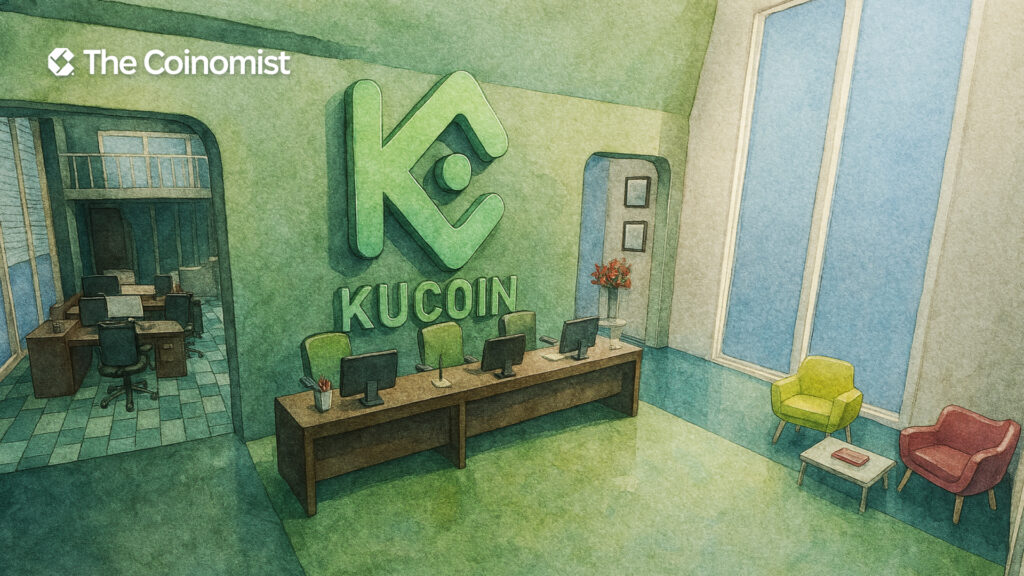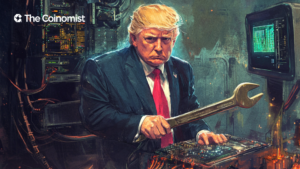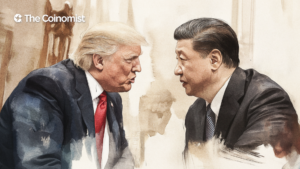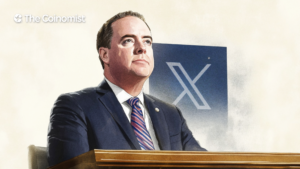KuCoin’s Global Strategy: Inside a Fast-Growing Crypto Exchange

From a startup to a global contender, the journey of the KuCoin exchange has been driven by bold moves in emerging markets and shaped by mounting regulatory pressure.
On this page
- Origins: How Frustration Turned Into a Mission
- From Code to Concept: The Roots of KuCoin Exchange
- The Birth of the People's Exchange
- The Token That Started It All
- Rapid Growth from the Start
- An Altcoin Haven: The Strategy That Brought the Crowd
- Riding the Wave: Crisis, Recovery, and a New Chapter
- KCS Token: Incentives That Work
- Expanding the Toolkit: Futures, Bots, NFTs, and More
- Regulatory Pressure: Striking a Balance on the Global Stage
- U.S. Enforcement Actions
- Growing Pressure from Global Regulators
- A New Survival Strategy
- From Rebel to Regulated Player
- Looking Ahead: Can KuCoin Exchange Hold Its Lead?
When Bitcoin was just starting to appear in global headlines, a future major player quietly launched behind the scenes. A team of blockchain developers and crypto enthusiasts introduced a new crypto exchange: KuCoin.
They didn’t come out of Silicon Valley. They didn’t have a license in New York. And they weren’t trying to impress Wall Street.
Instead, they followed a bold and unconventional vision: to build a People’s Exchange. That vision has since pushed KuCoin exchange to the forefront as one of the largest crypto trading platforms in the world.
So how did a small startup, launched by a few tech-savvy founders, grow into a centralized exchange with more than 38 million users across 200+ countries?
The answer lies in KuCoin’s global approach from the very beginning, its strong focus on emerging markets, and a product strategy that often went against mainstream trends.
This is the inside story of KuCoin’s international strategy and the intense race that brought the crypto exchange to where it is today.

Related: KuCoin Launches KuCoin Pay — Redefining Retail Payments
Origins: How Frustration Turned Into a Mission
From Code to Concept: The Roots of KuCoin Exchange
KuCoin’s story doesn’t start in a corporate office. It begins with two developers from China. In 2013, future co-founders, including Michael Gan, began exploring blockchain technology. Gan, a former engineer at Ant Financial (a subsidiary of Alibaba), saw the potential in cryptocurrencies.
Their motivation came from firsthand experience. Most early crypto exchanges (especially the infamous Mt. Gox) were clunky, chaotic, and lacked proper security. The founders of KuCoin believed they could build something better—a global, secure, and user-friendly platform accessible to everyone.

The Birth of the People's Exchange
For the next few years, the founders quietly worked on the project. In September 2017, KuCoin officially launched. The name was chosen to be simple and welcoming. In Chinese internet slang, “Ku” roughly translates to “cool.”
Their goal?
To create an exchange that functioned not just as a trading platform but as a community. It had to be easy to understand, accessible to everyone, modern, multilingual, and designed with everyday users in mind—not just hardcore traders.
Related: Crypto Exchange Hacks: The Methods Hackers Use and Self-Protection
The Token That Started It All
To fund the platform, KuCoin launched an Initial Coin Offering (ICO). The project’s token, KCS (KuCoin Shares), was more than just a way to raise capital. It introduced a profit-sharing model that allowed users to earn daily rewards from the exchange’s trading fee revenue.
The ICO raised around $27.5 million in Bitcoin, which provided enough resources to build the platform’s technical infrastructure and start growing its user base.
Related: KuCoin (KCS): A Utility Token of the KuCoin Ecosystem
Rapid Growth from the Start
KuCoin quickly made a name for itself. Within just three months of launching, the crypto exchange had attracted over 300,000 users. Its clean interface, strong emphasis on security, and generous token reward system helped it stand out in a crowded and overheated market.
From the beginning, KuCoin focused on a clear mission: to make cryptocurrency accessible to everyone.
Related: Crypto Swap Services vs Exchanges: Key Differences Explained
An Altcoin Haven: The Strategy That Brought the Crowd
While most competitors focused on Bitcoin and Ethereum, KuCoin chose a different path and quickly built a reputation as an altcoin trading platform.
From the very beginning, the KuCoin team concentrated on listing hundreds of lesser-known tokens, often referred to as hidden gems. This approach attracted early crypto enthusiasts, DeFi supporters, and global traders looking to access new projects before they appeared on larger exchanges.
By 2022, KuCoin had listed more than 700 cryptocurrencies and over 900 trading pairs. This wide selection gave the platform a clear strategic edge. New projects aimed to get listed on KuCoin, while traders in search of innovation often made it their starting point.
The strategy paid off. In just four years, KuCoin surpassed 10 million registered users. By the end of 2024, that number had nearly quadrupled to 38 million.
As CEO Johnny Lyu, who took over leadership in 2020, said:
We are not only building a trading platform, but a home for blockchain enthusiasts around the world.
Riding the Wave: Crisis, Recovery, and a New Chapter
However, KuCoin's path has not been without dramatic turns. In September 2020, the exchange was hit by one of the largest hacks in crypto history. Hackers drained nearly $280 million worth of digital assets from KuCoin’s hot wallets.
For many exchanges, an incident like this would have been the end. But KuCoin chose a different outcome.
The team responded immediately. They:
- paused withdrawals,
- moved assets,
- and launched a recovery operation.
Moreover, the exchange partnered with other platforms and blockchain investigators. Over time, they recovered 78% of the stolen funds. The rest was covered by insurance.
CEO Johnny Lyu addressed the community directly:
All user funds are safe. We will not let this define us.
That level of transparency and determination helped KuCoin not only recover but return even stronger.

Related: The KuCoin Case: A Prelude to Major Cleanups?
KCS Token: Incentives That Work
At the core of the KuCoin platform is its native token, KCS. Unlike most exchange tokens that simply offer trading fee discounts, the KCS token gives holders a share of the platform’s success. KuCoin distributes 50% of its trading fee revenue to KCS holders, creating a system of daily dividends.
This model has turned KCS into more than just a utility token. It has become a way for users to earn alongside the platform’s growth.
As KuCoin expanded, the value of KCS grew as well. By 2024, the token had over 2 million holders and a market capitalization of over $1.7 billion.
KCS is also connected to KuCoin’s blockchain initiative, the KuCoin Community Chain (KCC), which supports DeFi, NFTs, and other Web3 projects.
As this ecosystem grows, KCS could become a key part of KuCoin’s broader Web3 ambitions.
Expanding the Toolkit: Futures, Bots, NFTs, and More
Over time, KuCoin has introduced a wide range of tools designed for modern crypto users:
- KuCoin Futures offers dozens of contracts with high leverage and the option to use copy trading.
- Trading bots help users automate their strategies. By 2024, users had launched over 7.5 million bots.
- KuCoin Earn includes staking, lending, and fixed-income products, giving token holders multiple ways to earn passive income.
- Windvane, KuCoin’s NFT marketplace launched in 2022, features curated drops and fractional NFT investments.
While many centralized exchanges struggle to innovate, KuCoin moves quickly and often brings new products to market ahead of larger competitors.
Regulatory Pressure: Striking a Balance on the Global Stage
U.S. Enforcement Actions
KuCoin’s rapid rise eventually drew the attention of regulators. In 2023, the New York Attorney General filed a lawsuit against the centralized exchange, accusing it of operating without the necessary license. The case focused on KuCoin’s crypto trading and staking services, which were classified as unregistered securities.
KuCoin chose to settle, paying $22 million and agreeing to block access for users based in New York.
However, the pressure didn’t end there.
In 2024, the U.S. Department of Justice brought charges against two KuCoin co-founders, claiming the company violated the Bank Secrecy Act by failing to implement a proper anti-money laundering program. However, both founders remain outside the United States and have not yet appeared in court. The legal proceedings are still underway.
Growing Pressure from Global Regulators
KuCoin has also come under scrutiny in several other countries. In Canada, regulators issued a permanent ban on the exchange's operations in Ontario and fined the company for violating securities laws. In the Netherlands, the central bank issued a public warning, stating that KuCoin exchange was providing services without the required registration, making its operations illegal.
At the same time, the UK Financial Conduct Authority (FCA) added KuCoin to its list of unregistered crypto firms. This move effectively barred the platform from doing business with or advertising to UK residents.
Taken together, these actions send a clear signal. KuCoin’s global expansion strategy, built around rapid growth with limited regulatory oversight, is no longer sustainable in a world where the crypto industry faces increasing scrutiny.
Related: BitMEX and KuCoin Face South Korean Sanctions Over Unlicensed Operations
A New Survival Strategy
In response to mounting regulatory pressure, KuCoin began implementing major reforms.
The platform restricted access for users in high-risk jurisdictions, including certain regions of the United States and Canada. Additionally, it strengthened its Know Your Customer (KYC) and Anti-Money Laundering (AML) procedures, marking a significant shift for a crypto exchange once known for its easy onboarding process.
However, one of the most symbolic changes came in January 2025 with the appointment of a new CEO, BC Wong. Previously the company’s chief legal officer, Wong brought extensive experience in compliance and regulatory affairs.
Our top priority is building a reliable and compliant platform that users can trust,
Wong said in a public statement shortly after stepping into the role.

From Rebel to Regulated Player
For KuCoin, the message was clear: the days of rapid growth and staying under the radar are over. If the exchange wants to survive in the long run and keep its global reach, it should play by the rules.
That transition has already begun. KuCoin is restructuring its internal operations, strengthening its legal systems, and opening direct communication with regulators around the world.
The path forward will be challenging.
But if KuCoin can maintain its innovative edge while meeting regulatory expectations, it has a strong chance of remaining one of the most resilient companies in the crypto industry.
Looking Ahead: Can KuCoin Exchange Hold Its Lead?
Today, KuCoin is one of the top 5 crypto exchanges in the world by trading volume. It serves millions of users, features in major industry rankings, and its brand is recognized across several continents.
KuCoin’s path to success was unconventional from the start. The exchange didn’t raise billions in venture capital, didn’t build regulatory partnerships early on, and didn’t rely on high-profile PR campaigns.
Instead, it focused on steady growth by serving users that many other platforms ignored.
Now that regulation is tightening and the crypto market is maturing, KuCoin faces a new challenge:
Can it become a fully compliant and sustainable centralized exchange without losing the spark that made it unique?
In many ways, KuCoin’s global strategy was more than just a business decision. It was a mission built on inclusion—a commitment to giving people access to financial tools regardless of where they live.
That mission remains just as important today.
And KuCoin, despite the scars, is still in the game.
Still looking ahead.
The content on The Coinomist is for informational purposes only and should not be interpreted as financial advice. While we strive to provide accurate and up-to-date information, we do not guarantee the accuracy, completeness, or reliability of any content. Neither we accept liability for any errors or omissions in the information provided or for any financial losses incurred as a result of relying on this information. Actions based on this content are at your own risk. Always do your own research and consult a professional. See our Terms, Privacy Policy, and Disclaimers for more details.

























